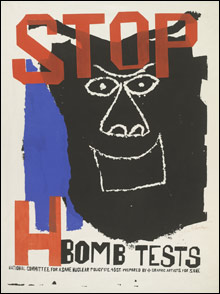Five centuries of protest art at Harvard
By BY GREG COOK | January 2, 2007

STOP H BOMB TESTS Ben Shahn’s 1960 anti-nuke fundraising poster remains striking and fresh. |
In 1969, Harvard University students rallied to support the creation of a black-studies program and protest the Vietnam War, the presence of ROTC on campus, and the university’s expansion into surrounding communities. Events boiled over when protesters commandeered University Hall and police, on administration orders, roughly evicted them. Hotheads on all sides prevailed. A T-shirt printed at the Harvard Strike Poster Workshop in the midst of the hubbub, and included in the exhibit “Dissent!” at Harvard’s Fogg Museum, bears a blocky red fist and a wonderful long list of student grievances: “Strike because you hate cops . . . strike to become more human . . . strike because there’s no poetry in your lectures . . . strike to smash the corporation . . . strike to abolish race . . . strike because they are trying to squeeze the life out of you.”“Dissent!” is a fiery greatest hits of five centuries of such protest art. Here’s Édouard Manet’s circa 1871 lithograph of French soldiers firing into a Paris crowd. There’s a 16th-century Reformation woodcut complaining that the pope is playing us for suckers; we see a wolf wearing a pope hat seducing sheep away from Jesus. A 1770 knockoff of a Paul Revere broadside (who was knocking off somebody else) shows dastardly redcoats gunning down Bostonians in what became known as the Boston Massacre. The 62 prints and publications offer a who’s who of art rabble rousers: Honoré Daumier, Francisco de Goya, Käthe Kollwitz, José Guadalupe Posada, Pablo Picasso, Joseph Beuys. It’s important that we see and study this stuff, but the challenge for institutional exhibits — a challenge curator Susan Dackerman doesn’t solve — is how to embrace protest art without neutralizing it.
The works that retain the most power to inspire are the Technicolor posters of Sister Corita, a Los Angeles Roman Catholic nun and college art teacher who left the sisterhood and moved to Boston in 1968 — where her legacy is most prominent as the designer of those rainbow stripes on the Boston Gas tank along Route 93 in Dorchester. The show offers six eye-popping hot-pink, blue, and yellow screenprints from 1969 that condemn the Vietnam War, poverty, and the oppression of African-Americans. Corita, who died in 1986, had a pop sensibility, often appropriating and rejiggering corporate logos, package designs, and advertising slogans. Here she incorporates images of a mourning Coretta Scott King, a smiling Eugene McCarthy, a black boy crying on the cover of Life magazine, a captured Vietcong fighter from the front of Newsweek. A Passion for the Possible takes a quote from Yale chaplain and activist William Sloane Coffin: “Realism demands pessimism, but hope demands that we take a dim view of the present because we hold a bright view of the future, and hope arouses as nothing else can arouse a passion for the possible.” Corita creates sparks by combining such subtle and moving texts — they often sound like something e.e. cummings might have written — with her crackerjack eye for color, typography, and composition, an eye that’s apparent here as she creates rhythm and emphasis by switching back and forth between mechanical typefaces and her handwritten script.
 Related
Related:
Will Harvard get presidential in ’08?, Les Moonves Leads Commencement Charge, Nudity throughout history, More 
- Will Harvard get presidential in ’08?
As the pool of presidential candidates starts to take shape, some people are looking for leadership, ideas, or experience.
- Les Moonves Leads Commencement Charge
Talk about poor alumni relations.
- Nudity throughout history
- Flashbacks, March 10, 2006
These selections, culled from our back files, were compiled by Chris Brook and Jessica McConnell.
- Dated advice
To boink a lot or not to boink a lot?
- Are universities selling out to oil nations?
As Academia searches for elusive dollars in a downward economy, oil-rich nations are enticing American schools to open satellite campuses in the Gulf.
- Will Harvard drop acid again?
In a moment of delightful whimsy in the annals of drug history, Albert Hofmann, after purposely ingesting LSD for the first time, rode his bicycle home and experienced all manner of beatific and hellish visions.
- Harvard Beats Yale 29-29
Kevin Rafferty's 40th-anniversary documentary about the fabled Game of 1968 — when both teams were unbeaten and Harvard, after being completely outplayed by the 16th-ranked Elis, scored 16 points in the final 42 seconds to "win" — has no designs on being innovative: contemporary interviews with the players are intercut with slightly fuzzy but quite acceptable footage of the game.
- Cheer of a black planet
It's hip-hop week at Harvard University. And while that statement is far less ironic than it would have been 15 years ago, it's still relatively humorous.
- Free speech again quashed at Harvard
It should come as no surprise to readers of “Freedom Watch” that yet another instance of political, intellectual, and academic censorship has sprung up at Harvard, the self-touted pinnacle of higher education.
- Boston rat rampage
Residents say that if you jam a leaf blower in the earth virtually anywhere in Allston, furry bottom feeders will be blown out of every crack and hole in sight and rain down like unsavory screeching meatballs. North Enders joke that something similar would happen if you detonate a Parmesan wheel in an alleyway off Hanover Street.
- Less

 Topics
Topics:
Museum And Gallery
, Jenny Holzer, Peter Schumann, Ben Shahn, More  , Jenny Holzer, Peter Schumann, Ben Shahn, Richard Serra, Joseph Beuys, Raymond Pettibon, Harvard's Fogg Museum, Paul Revere, U.S. Army ROTC, Coretta Scott King, Less
, Jenny Holzer, Peter Schumann, Ben Shahn, Richard Serra, Joseph Beuys, Raymond Pettibon, Harvard's Fogg Museum, Paul Revere, U.S. Army ROTC, Coretta Scott King, Less 